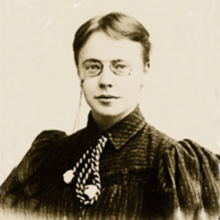Vera Yevstafievna Popova, née Vera Bogdanovskaya (Russian: Вера Евстафьевна Попова; 17 September 1867 – 8 May 1896) was a Russian chemist. She was one of the first female chemists in Russia,[3] and the first Russian female author of a chemistry textbook.[4] She "probably became the first woman to die in the cause of chemistry" as a result of an explosion in her laboratory.[5]
Vera Popova | |
|---|---|
 | |
| Born | (née Bogdanovskaya) 17 September 1867[1] |
| Died | 8 May 1896 (aged 28)[1] (Gregorian calendar); 26 April (Julian Calendar).[2] |
| Cause of death | Explosion |
| Known for | Early Russian chemist |
| Spouse | General Jacob Kozmich Popov |
| Parent(s) | Yevstafy Ivanovich Bogdanovsky and Maria Alexeyevna Bogdanovskaya |
Early life and education
editVera Bogdanovskaya was born in 1867 in Saint Petersburg. Her father, Evstafy Ivanovich Bogdanovsky, was a professor of surgery. Her parents arranged for their three children to be educated at home. In 1878, she began studying at the Smolny Institute at the age of 11. Starting in 1883 she spent four years at the Bestuzhev Courses and after this she worked for two years in laboratories at the Academy of Sciences and the Military Surgical Academy. In 1889 Bogdanovskaya left Russia for Switzerland, where she undertook a doctorate in chemistry at the University of Geneva. She defended her research into dibenzyl ketone in 1892.[1] Bogdanovskaya wanted to work on H-C≡P (methylidynephosphane), but had been persuaded to concentrate instead on dibenzyl ketone by her doctoral supervisor, Professor Carl Gräbe.[5] She also worked with Dr Philippe Auguste Guye in Geneva, who was working on stereochemistry.[2]
Career
editBogdanovskaya returned to Saint Petersburg in 1892 to work at the Bestuzhev Courses, where she taught chemistry. This was an institution founded in 1878 to encourage Russian women to stay in Russia to study. She was working as an assistant to Prof. L'vov teaching the first courses in stereochemistry. Her reputation as a lecturer and her knowledge of teaching enabled her to write her first book, a textbook on basic chemistry.[4] She wrote reviews, translated academic papers on chemistry and, together with her professor, published the works of Alexander Butlerov, who had died in 1886.[1] Between 1891 and 1894, she published a number of papers based on her doctoral thesis.
She was not just a chemist; she was also interested in entomology, writing and languages. In 1889, she published a description of work with bees. Bogdanovskaya published her own short stories, as well as her translations of the French short story writer Guy de Maupassant.[1]
Personal life
editBogdanovskaya left Saint Petersburg and married General Jacob Kozmich Popov in 1895. He was older than she and a director of a military steel plant, and she demanded that he build her a laboratory where she could continue her chemistry.[5] They lived in Izhevskii Zavod, a town under military control that was dedicated to weapon manufacture.[1] It has been suggested that her marriage may have been one of convenience, as it was known that Russian women sometimes married just to escape the conventions of society.[2]
Death
editPopova died on 8 May 1896 (Gregorian calendar; 26 April in the Julian Calendar),[1][2] (the date is sometimes given as 1897 in English sources) as a result of an explosion which occurred while she was attempting to synthesize H-C≡P (methylidynephosphane), a chemical similar to hydrogen cyanide.[5] She was 28.
Aftermath
editH-C≡P, the chemical that she was trying to synthesize at the time of her death, was not successfully created until 1961 from phosphine and carbon.[6] It is extremely pyrophoric and polymerizes easily at temperatures above −120 °C. Its triple point is −124 °C and it burns spontaneously even at low temperatures when exposed to air.[6]
Legacy
editPopova was given a substantial tribute in the Journal of the Russian Physical Chemical Society.[7] A shorter obituary appeared in the journal Nature[8] and a brief notice in the American journal Science.[9] One report by the chemist Vladimir Ipatieff suggested that she may have been poisoned by her experiment or have committed suicide, but this view was not supported by other reports.[2]
Her early death led to a fund being created in her memory by her husband to assist female students.[citation needed] Her portrait was also displayed at the Women's College where she had trained.[citation needed]
Popova is credited with classifying dibenzyl ketone. This laid the foundation for synthetic acrylic resins created from acetone cyanohydrin.[1]
References
edit- ^ a b c d e f g h Anne C. Hughes, "Vera Evstaf'evna Bogdanovskaia," in Marilyn Ogilvie, Joy Harvey, and Margaret Rossiter (eds.), Biographical Dictionary of Women in Science: Pioneering Lives from Ancient Times to the Mid-Twentieth Century. New York: Routledge, 2014; pg. 153.
- ^ a b c d e Elder, Eleanor S; et al. (April 1979). "The Deadly Outcome of Chance-Vera Estaf'evna Bogdanovskaia". Journal of Chemical Education. 56 (4): 251–2. Bibcode:1979JChEd..56..251E. doi:10.1021/ed056p251.
- ^ Ledkovskaia-Astman, Marina; Rosenthal, Charlotte; Zirin, Mary Fleming (1994). Dictionary of Russian Women Writers. Westport, CT: Greenwood Publishing Group. ISBN 978-0-313-26265-4.
- ^ a b Rulev, Alexander Yu.; Voronkov, Mikhail G. (2013). "Women in chemistry: a life devoted to science". New Journal of Chemistry. 37 (12): 3826. doi:10.1039/C3NJ00718A.
- ^ a b c d Rayner-Canham, Marelene; Rayner-Canham, Geoffrey (2001). Women in Chemistry: Their Changing Roles from Alchemical Times to the Mid-twentieth Century. Philadelphia: Chemical Heritage Foundation. p. 64. ISBN 978-0-941901-27-7.
- ^ a b Gier TE (1961). "HCP, A Unique Phosphorus Compound". Journal of the American Chemical Society. 83 (7): 1769–1770. doi:10.1021/ja01468a058.
- ^ Gustavsona, G. (1897). "A few words about Vera Estaf'evna Bogdanovskaia". Journal of the Russian Physical Chemical Society. 29: 147–151.
- ^ "Obituary". Nature. 56 (1441): 132. 16 July 1897. Bibcode:1897Natur..56R.129.. doi:10.1038/056129c0.
- ^ "Scientific Notes and News". Science. 6 (133): 96. 1897. Bibcode:1897Sci.....6...94.. doi:10.1126/science.6.133.94.